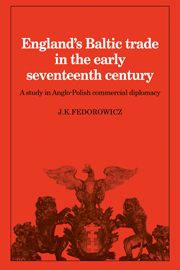 England's Baltic Trade in the Early Seventeenth Century
England's Baltic Trade in the Early Seventeenth Century Book contents
- Frontmatter
- Contents
- Preface
- List of maps and graphs
- List of abbreviations
- Map
- Introduction
- 1 English perceptions of the Polish Commonwealth
- 2 The mechanics of English diplomacy in the Eastland
- 3 The early history of the Eastland Staple at Elbing
- 4 The operation of the staple
- 5 The pattern of English shipping into the Baltic
- 6 English exports to the Baltic
- 7 English imports from the Baltic
- 8 The threat to the Eastland Staple at Elbing
- 9 The depression of 1620 and the crisis of England's Baltic trade
- 10 The political crisis, 1620–9
- 11 The mission of Sir Thomas Roe to the Eastland
- 12 Attempts at reconciliation with Danzig, 1630–5
- 13 The climax of English commercial diplomacy, 1635–42
- 14 Conclusion
- Notes
- Bibliography
- Index
5 - The pattern of English shipping into the Baltic
Published online by Cambridge University Press: 05 November 2011
- Frontmatter
- Contents
- Preface
- List of maps and graphs
- List of abbreviations
- Map
- Introduction
- 1 English perceptions of the Polish Commonwealth
- 2 The mechanics of English diplomacy in the Eastland
- 3 The early history of the Eastland Staple at Elbing
- 4 The operation of the staple
- 5 The pattern of English shipping into the Baltic
- 6 English exports to the Baltic
- 7 English imports from the Baltic
- 8 The threat to the Eastland Staple at Elbing
- 9 The depression of 1620 and the crisis of England's Baltic trade
- 10 The political crisis, 1620–9
- 11 The mission of Sir Thomas Roe to the Eastland
- 12 Attempts at reconciliation with Danzig, 1630–5
- 13 The climax of English commercial diplomacy, 1635–42
- 14 Conclusion
- Notes
- Bibliography
- Index
Summary
The nature of the sources
In attempting to illuminate England's Baltic trade in the seventeenth century by studying the extant shipping records of the period, one immediately encounters severe limitations. Perhaps the most serious is simply that such a study of necessity ignores any overland traffic. It is certain that at least some English cloth reached Poland by way of the overland route from Hamburg, but the evidence for this is fragmentary at best. In the winter of 1608, when the sea lanes became dangerous, Cranfield's factors at Stade inquired about the rates for transportation of cloth by land. After Danzig obtained in 1628 the odious sealing privilege on all cloth imports to Poland, the English were quick to inquire as to whether this included imports by land: Sir Thomas Roe managed to secure from the Polish government an interpretation which specifically excluded overland imports from Germany and Constantinople (sic), and in this way freed as many as 1,000 cloths stayed at Frankfurt am Oder until a decision should be made on the applicability of Danzig's privilege. Rybarski discusses overland cloth imports to Poland in very general terms and it is difficult to determine from his account whether or not any substantial amounts of English cloth entered Poland through her western borders. Heckscher, on the other hand, suggests that apparent trade imbalances in the Baltic's maritime exchanges might have been rectified by overland shipments. For this to have been the case, the overland shipments would have had to have been substantial indeed.
- Type
- Chapter
- Information
- England's Baltic Trade in the Early Seventeenth CenturyA Study in Anglo-Polish Commercial Diplomacy, pp. 73 - 89Publisher: Cambridge University PressPrint publication year: 1980


